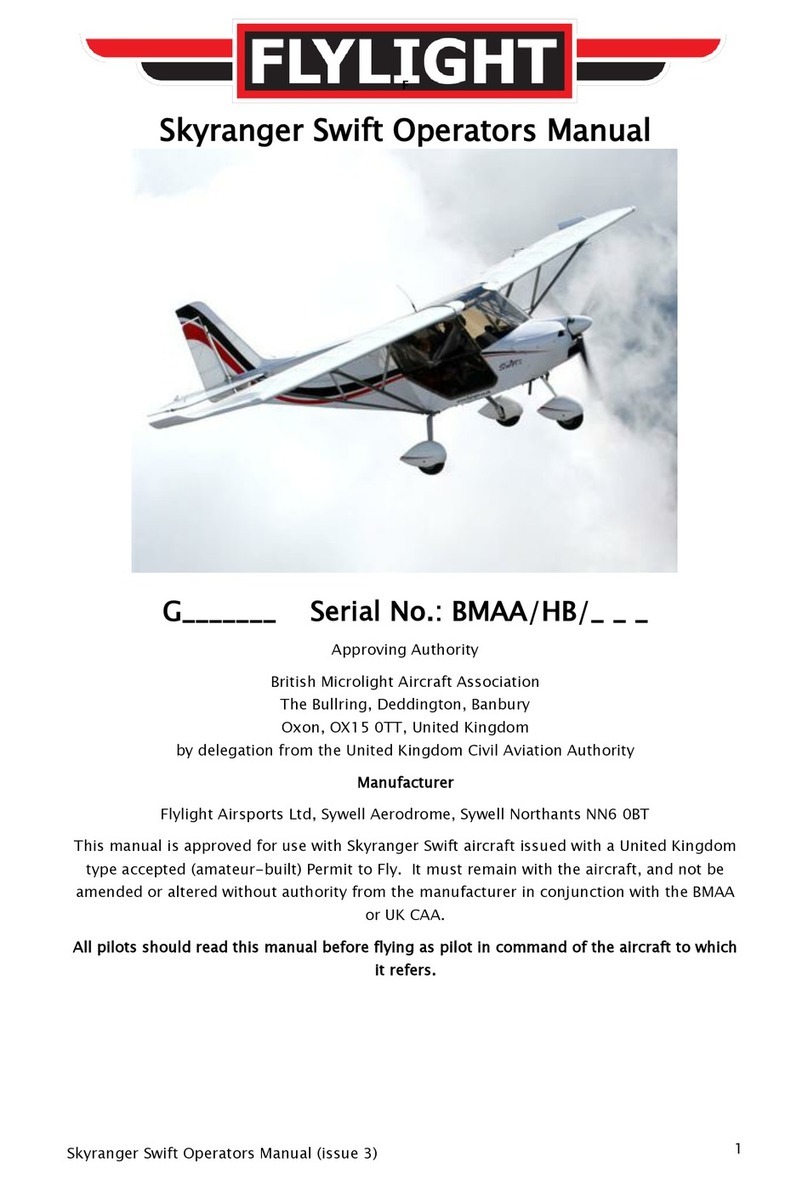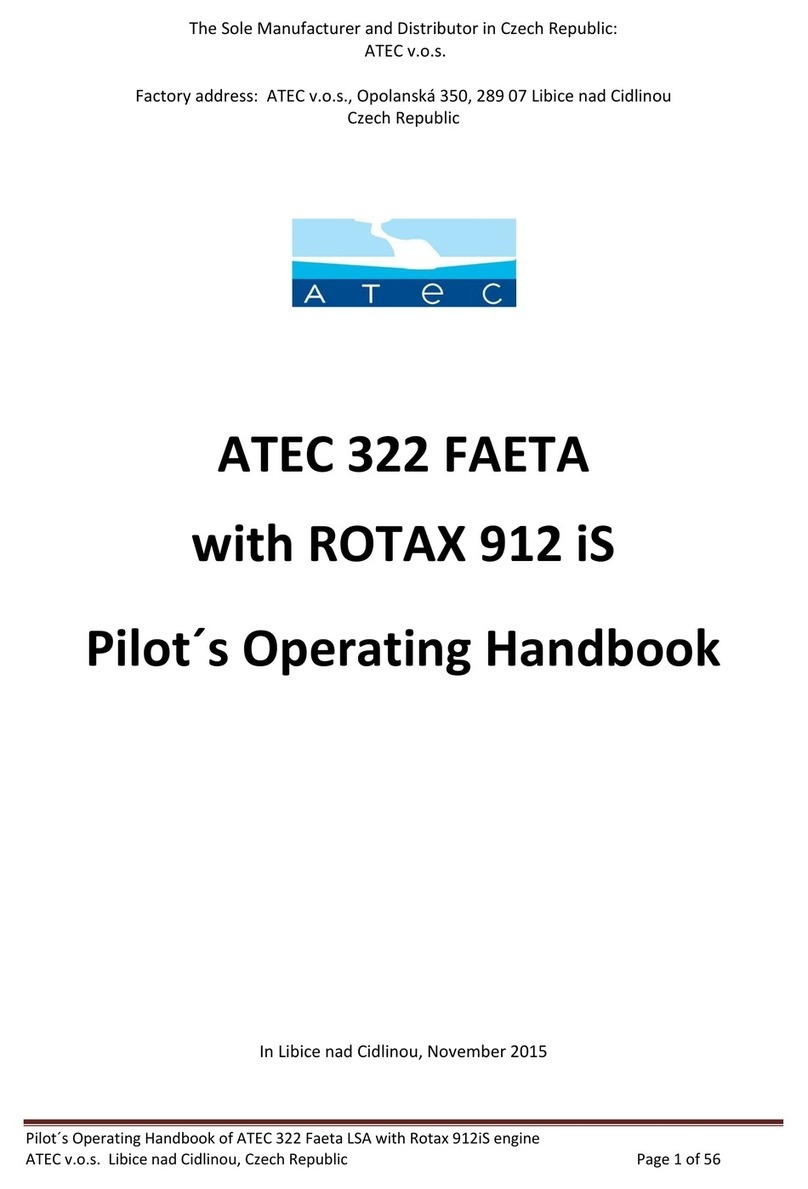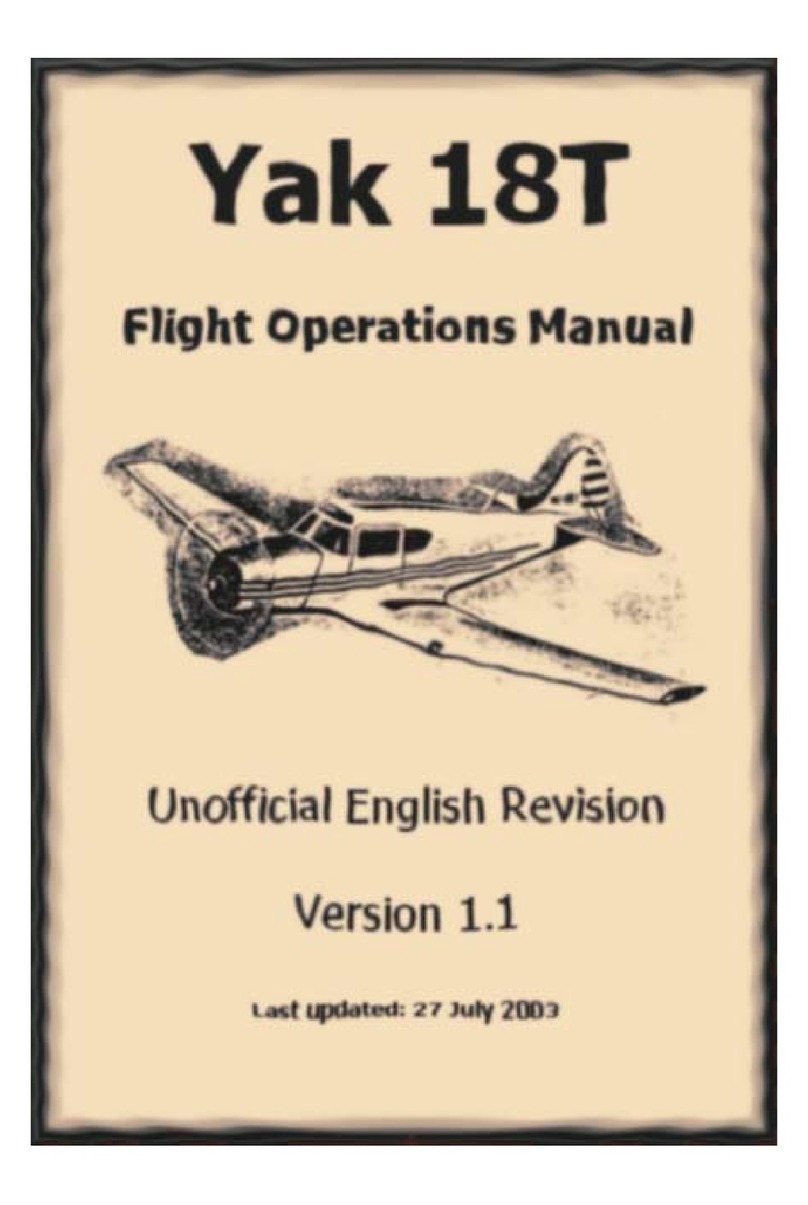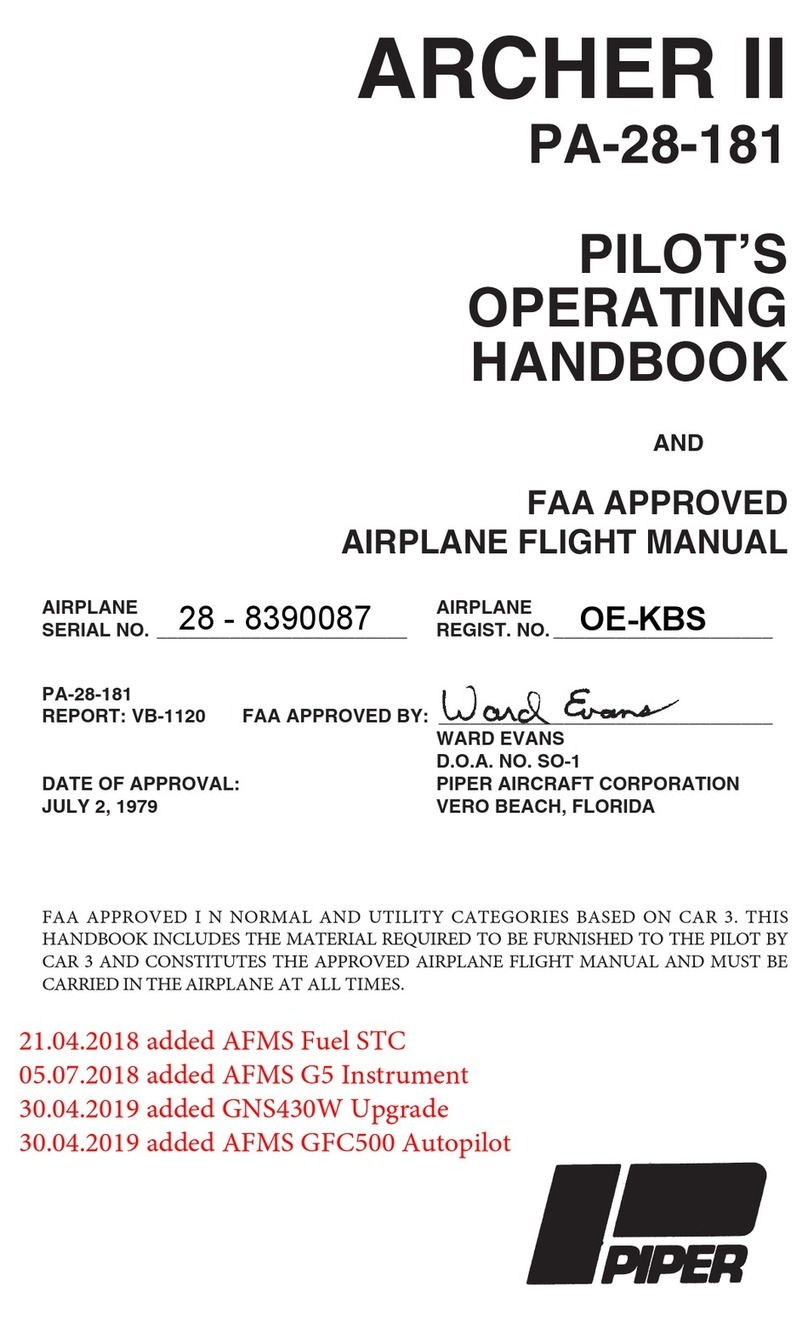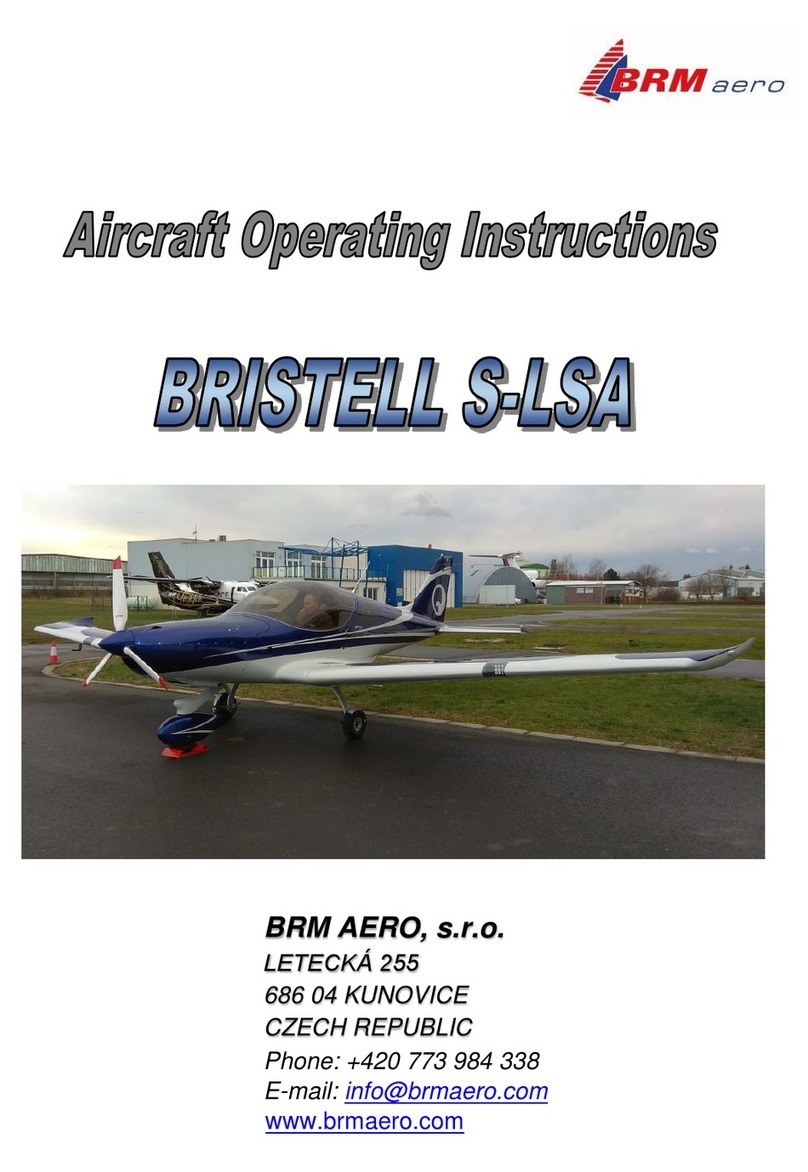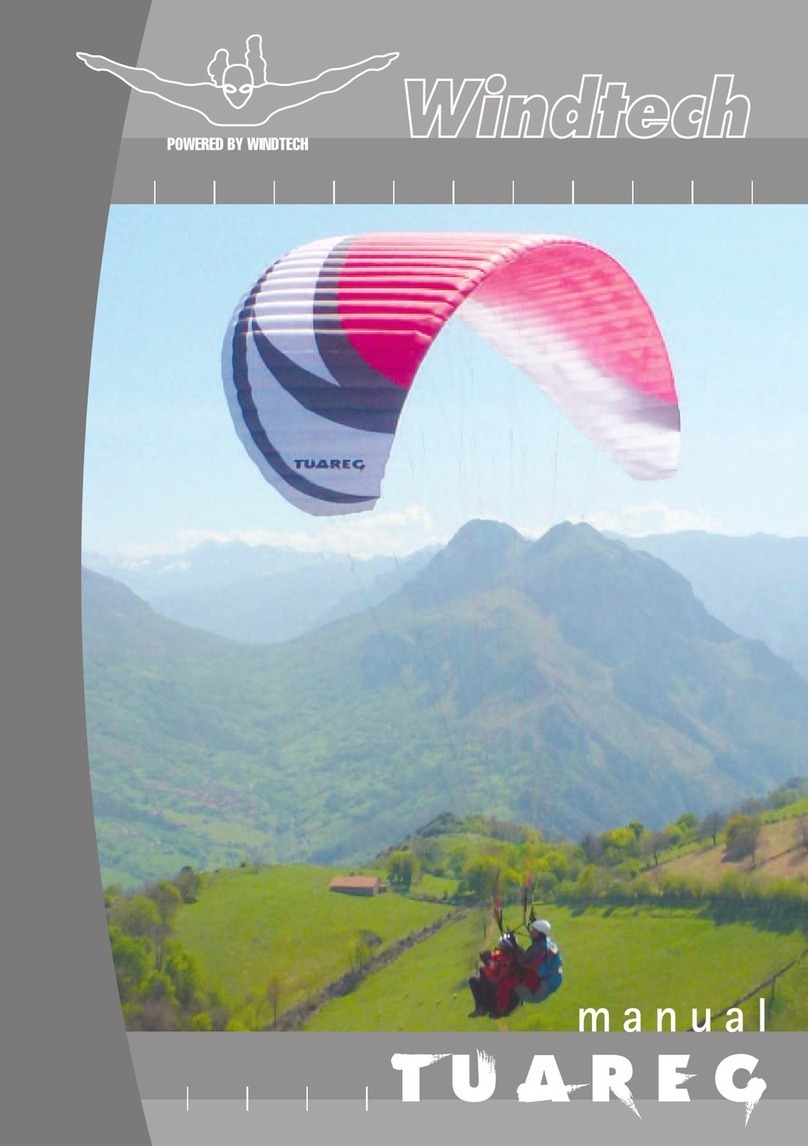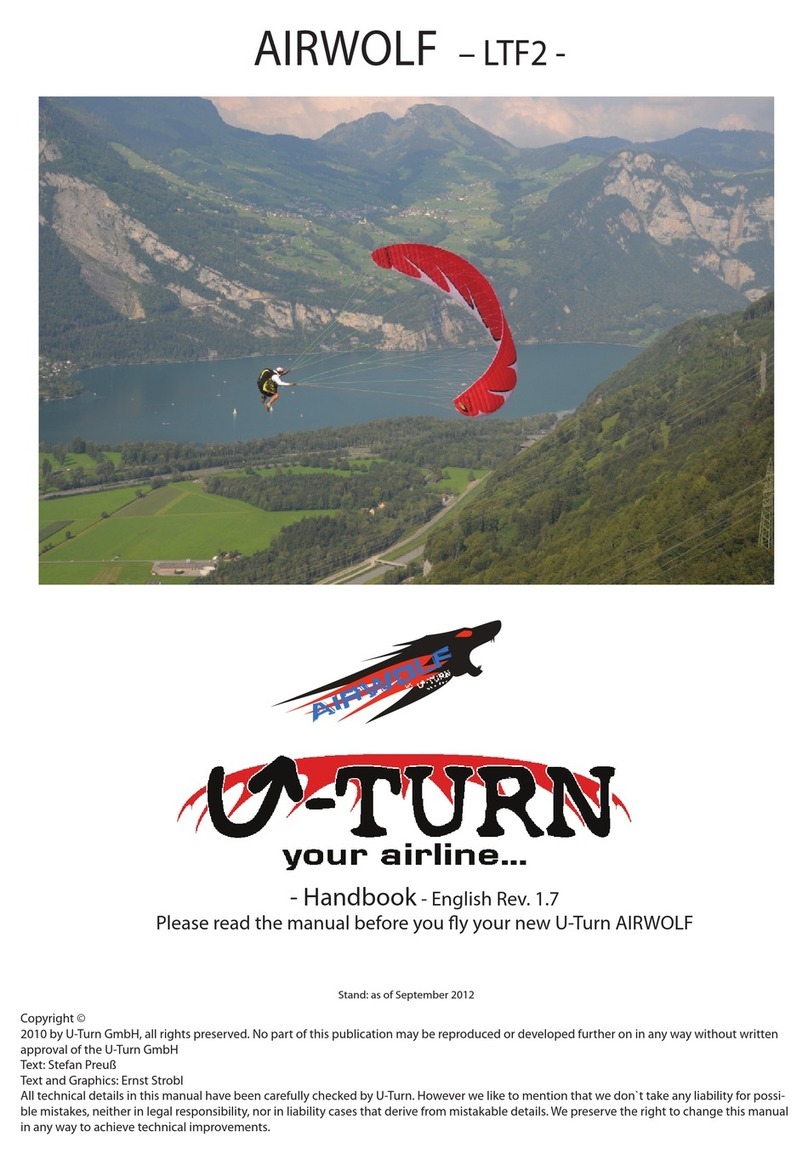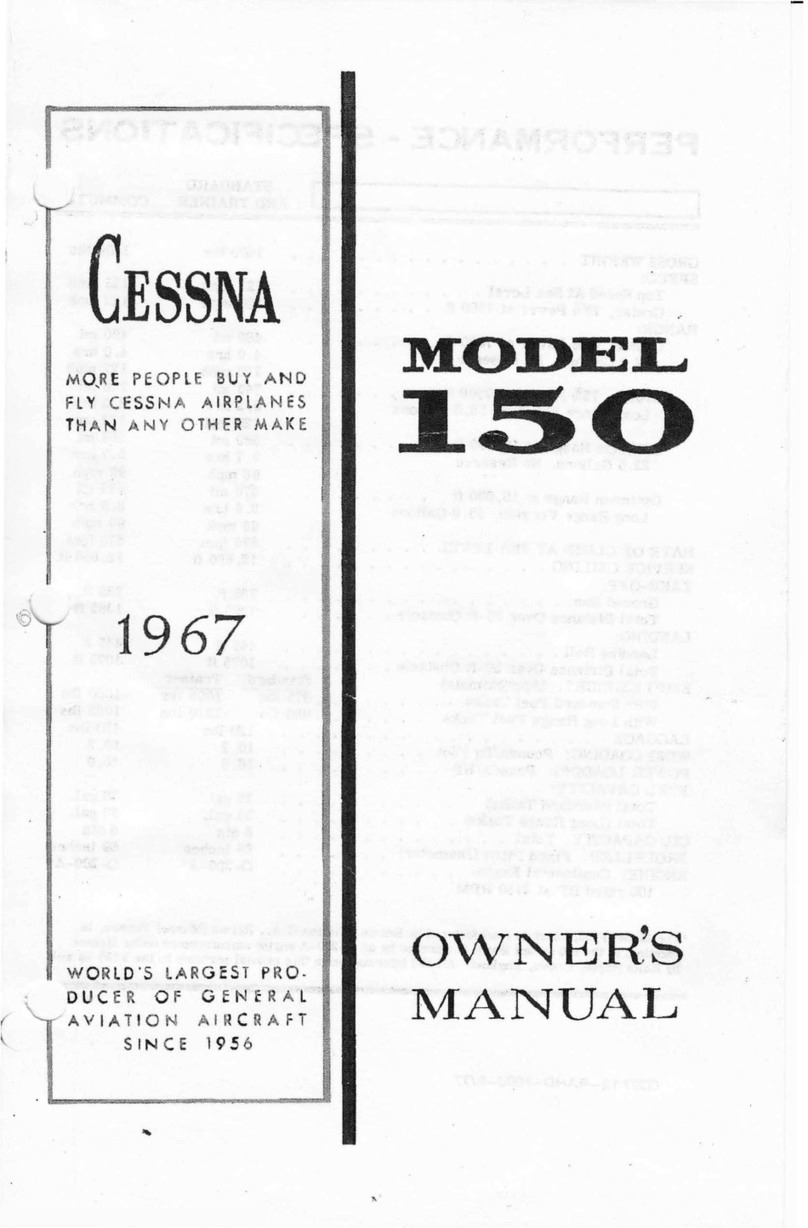Flylight Airsports SkyRanger Nynja 600 User manual

SkyRanger Nynja 600 Operators Manual issue 1
1
SkyRanger Nynja 600 Operators & Maintenance Manual
G - _ _ _ _ Serial No.: _ _ _ _ _ _
Manufacturer
Flylight Airsports Ltd
DAI/9967/18
Sywell Aerodrome,
Sywell, Northants, NN6 0BT
United Kingdom
This manual is approved for use with SkyRanger Nynja aircraft constructed by Flylight
Airsports and issued with a United Kingdom Type Approved Permit to Fly. It must remain
with the aircraft, and not be amended or altered without authority from the manufacturer.
All pilots should read this manual before flying as pilot in command of the aircraft to which
it refers.

SkyRanger Nynja 600 Operators Manual issue 1
2
1600

SkyRanger Nynja 600 Operators Manual issue 1
3
Contents
1. Introduction ....................................................................................... 5
2. Description of the Aircraft .................................................................. 6
3. Limitations ......................................................................................... 8
4. Flying the Nynja ............................................................................... 10
5. Performance..................................................................................... 21
6. Emergencies..................................................................................... 23
7. Rigging and De-rigging.................................................................... 25
8. Weight and Balance .......................................................................... 27
9. Maintenance .................................................................................... 31
10. Repairs ............................................................................................ 45
11. Trim and tuning ............................................................................... 47
12. Vital Statistics................................................................................... 49
13 Air Speed Calibration........................................................................ 50
14. Example Placards ............................................................................. 51
Annex A Engine Manual
Annex B Weight and balance report for this aircraft
Annex C Modifications fitted to this aircraft
Annex D Instructions and Manuals for other devices fitted to this aircraft

SkyRanger Nynja 600 Operators Manual issue 1
4
TABLE OF AMENDMENTS
Reference
Changes incorporated
Approved, date
Issue 1
Initial issue for SkyRanger Nynja 600
11.02.2022

SkyRanger Nynja 600 Operators Manual issue 1
5
1. Introduction
1.1 The Nynja 600 is a three-axis ‘Light Sport Microlight’, Type Approved
in the United Kingdom using CS-VLA as a basis for approval to the Air
Navigation (Amendment) Order 2021/879 art.10(c) (August 19, 2021)
microlight definition up to 600kg
1.2 This manual is not intended to teach you to fly the aircraft, or to build
it. Learning to fly should be accomplished under the supervision of a
flying instructor experienced on the type.
1.3 What this manual will do, is provide the information which a qualified
pilot requires to safely fly this aircraft (although a conversion by an
instructor familiar with the type is strongly recommended), and to carry
out routine maintenance and minor repairs.
1.4 The license required to fly the Nynja 600 in the UK is an NPPL with a
microlight rating –and, where applicable, with differences training for
microlight aircraft above 475Kg. Pilots with licenses and experience
confined to heavier GA aircraft should check the validity of those
licenses to fly UK microlight aircraft and will normally be required to
carry out differences training to fly microlight aircraft such as the
Nynja 600. Pilots with microlight ratings trained for Flexwing aircraft
must carry out differences training for 3 Axis control systems before
attempting to fly the Nynja. Type familiarity training is strongly
recommended for pilots new to the Nynja.
1.5 This aircraft must be operated using airframe and engine log books.
Entries must be made in the logbooks in ink and within 7 days.

SkyRanger Nynja 600 Operators Manual issue 1
6
2. Description of the Aircraft
2.1 Ancestry
The SkyRanger was conceived by Philippe Prevot in 1991. After a
production run of 200, in 1998 the design was updated –known in the
UK as the SkyRanger ‘Classic’. A shorter wing model –The SkyRanger
Swift then followed in 2005. The SkyRanger Nynja was a further
development from the SkyRanger design introduced in the UK in 2010,
featuring a redesigned fuselage with fibreglass body fairings, and
detail aerodynamic, improvements, along with a reworked interior. In
2015 an LS variant was introduced to allow UK operation at 500kg
MTOW –outside of the Microlight category. In 2019 the Nynja gained
Type Approval as a factory-built microlight. In late 2021 the UK
adopted an increased weight definition allowing up to 600kg takeoff
weight. The Nynja 600 includes modifications to allow operation up to
the full 600kg MTOM.
2.2 Construction
The Nynja 600 is predominately constructed of pin-jointed straight
aluminium tubes with wings and tail covered with pre-sewn polyester
or optional laminate fabric. The fuselage is covered in non-structural
glass fibre panels.
2.3 Flying Controls
2.3.1 Pitch control is by fore-aft movement of the control stick, with
movement transmitted to a conventional elevator through cables.
2.3.2 Pitch trimming is by a hand-operated lever mounted in the central
console between the seats, with movement transmitted through a cable
to a trim-tab on the starboard elevator, reacted with springs.
2.3.3 Roll control is by sideward movement of the control stick, with
movement transmitted through cables to part-span, differential-
movement ailerons.
2.3.4 Yaw control is by dual-control foot pedals, with movement to the
rudder transmitted through cables.
2.3.5 Braking is by hand lever operated hydraulic disc brakes.
2.3.6 The undercarriage is of tricycle arrangement, with nose wheel steering
mechanically linked to the dual-control rudder pedals.

SkyRanger Nynja 600 Operators Manual issue 1
7
2.3.7 Flaps are lowered in two stages by lifting a hand-operated lever
located between the seats whilst gripping an integral latching lever.
2.4Fuel system
2.4.1 The standard fuel system consists of two polyethylene tanks linked
together with a balance pipe. As such they work as one single tank for
fuel management purposes.
2.4.2 Fuel is drawn from a single outlet through a single fuel tap which
isolates all supply.
2.4.3 Fuel is pumped by an engine driven mechanical fuel pump, and an
optional electrical back-up fuel pump. An anti vapour-lock restricted
return allows fuel flow back from the engine compartment to the fuel
tanks.
2.4.4 The tank outlet has a strainer, and an additional fuel filter is used in
the supply line.
2.5 Electrical system
2.5.1 The electrical system is based on a 12V battery which is charged via the
engine generator system producing a maximum output of 250watts /
21A. Please consult Rotax engine manuals, and the wiring section of
the Nynja build manual for more details.
2.5.2 A fusebox is positioned on the left side of the instrument binnacle
below the side pockets. Blade type fuses are used and a placard shows
details of fuse rating and the consumer that it supplies.
2.5.3 The voltmeter shows the state of the battery voltage. Voltage should be
greater when engine is running –indicating the charging system is
working.

SkyRanger Nynja 600 Operators Manual issue 1
8
3. Limitations
3.1 Introduction
This section includes the basic operating limitations for the Nynja 600.
The full limitations for the Nynja 600 are contained in Type Approval
Data Sheet (TADS) BM-91, which is used by the Inspector at Annual
Permit renewal to ensure, amongst other things, that the correct
limitations are placarded in the cockpit.
3.2 Units
When noting limitations, it is important to ensure that the limitations
which you are using use the same units and calibrations as the
instruments in the cockpit. The limitations stated in this manual are
Indicated Air Speeds (IAS) in both knots and MPH (as ASI’s with either
units may be fitted), appropriate to the air speed calibration
determined as correct for the Type Approved SkyRanger Nynja.
To convert to Calibrated Airspeed (CAS) the calibration data in Section
13 may be used. The difference between IAS and CAS is basically the
accuracy of the Pitot-static system.
3.3 Operational Limitations
3.3.1 The Nynja must only be flown in day VMC conditions.
3.3.2 The Nynja is certified to a "permit to fly" standard. This prohibits
commercial operation.
3.3.3 This aircraft is certified to a UK only standard, this means that
permission is required from the host country to fly it overseas. Several
reciprocal agreements exist with other countries to allow access. The
pilot should research agreements and requirements as part of any
planning for flights outside of the UK.
3.3.4 The minimum instrumentation required is specified in the Type
Approval Data Sheet (TADS) BM-91. Latest issues of which are available
on the BMAA website.
3.3.5 It is recommended that the Nynja 600 is not flown where a crosswind
component above 15 knots is predicted.
3.3.6 Do not fly above 10,000ft standard pressure altitude without the use of
personal oxygen.

SkyRanger Nynja 600 Operators Manual issue 1
9
3.3.7 Do not fly if any ice is present on the airframe. Performance, stability
and handling will all be degraded with dangerous consequences. Do
not fly the aircraft into known icing conditions.
3.4 Flight Limitations and key performance speeds
All speeds Indicated Air Speed (IAS).
Nynja 600
Never exceed speed, VNE
132 kn 152 mph
Max speed rough air, VNO
112 kn 129 mph
Manoeuvring speed, VA
90 kn 104 mph
Flap limiting speed, VFE
76 kn 87 mph
Door open limit speed
78 kn 90 mph
Speed for best rate of climb VY
65 kn 75 mph
Speed for best climb angle VX
57 kn 65 mph
Speed for best glide angle
58 kn 67 mph
Speed for minimum sink
48 kn 55 mph
3.4.2 Maximum Bank angles are 60° either way.
3.4.3 Maximum Pitch attitudes are 450 nose up and down from the
horizontal.
3.4.4 Normal acceleration limits are +4g / -2g.
3.4.5 At least 55kg (121lb / 8 stone 9lb) must be in the cockpit for flight,
no more than 120kg (264lb / 18stone 12lb) may be carried in each
seat.
3.4.6 Maximum Take-off weight: 600 kg
3.4.7 Aerobatics and deliberate spinning are prohibited.
3.5 Engine Limitations
The limitations for the engine are contained in Annex A, they are also
placarded in the cockpit.

SkyRanger Nynja 600 Operators Manual issue 1
10
4. Flying the Nynja
4.1 Pre-Flight Inspection and ground handling
4.1.1 Pre flight inspection –Check A, is detailed in the maintenance section.
4.1.2 Ground handling –the Nynja can easily be moved by one or more
persons pushing / pulling on substantial parts of the structure. When
moving forwards the root of a propeller blade close to the hub can be
pulled on. The front wing lift struts can also be pulled on. When
moving backwards the leading edge of the tailplane can be used to
push down on (so nosewheel is lifted and aircraft easily manoeuvred)
and pushed against. Take care not to push on fairings or directly on
fabric areas. Ground towing should not be done without using a system
approved by the manufacturer.
4.2 Starting
4.2.1 Before starting the engine with the intention of flight ensure that the
max take-off weight will not be exceeded and balance is within limits.
4.2.2 Start Procedure:
Brakes ON, facing safe direction - all clear in front and behind (prop
wash)
Flaps up (CR setting)
All Switches OFF, radio and transponder OFF
Master Switch ON
Fuel tap check ON
Electric fuel pump On for 5 secs when cold
Throttle CLOSED
Choke ON if cold
Ignitions (mags) both ON
Check clear all around and shout ‘CLEAR PROP!’
Start engine
(For first start of the day leave ignitions off and crank for 5 secs to bring up
oil pressure, then stop, put Ignitions on and start)

SkyRanger Nynja 600 Operators Manual issue 1
11
4.2.3 After start:
Set approximately 2000 RPM and ease choke fully OFF (note that the
ignition advance will occur shortly after start changing engine note and
RPM).
Check oil pressure is rising and within limits within 10 seconds.
Check charging (if charge switch fitted select ON at this stage and
observe Voltage rise)
Radio and Transponder ON.
4.3 Taxying
4.3.1 Before Taxying ensure that the engine has run for at least 2 minutes
from cold. Do not use high RPM until the engine has reached its
minimum flight operating temps.
4.3.2 Taxy at no more than a brisk walking pace, somewhat less if the
surface is rough. Steering is effected through the rudder pedals which
are linked directly to the nosewheel. The turning circle normally is
around 20 feet in diameter (at the aircraft centreline).
4.3.3 Relatively light weight aircraft like the Nynja 600 can be blown over in
winds over 25knots. It is imperative that when taxiing in strong winds
that the correct control placements are used. When the wind is from
the forward quarters hold the stick into wind and the elevator neutral.
When the wind is from the rear quarters the stick should be positioned
away from the wind and the elevator held down.
4.3.4 Taxy checks
When taxiing check:
Brakes functioning
Compass moving when aircraft turned
Slip ball moving when aircraft turned
Engine temps warming, no limits exceeded

SkyRanger Nynja 600 Operators Manual issue 1
12
4.4 Pre take-off checks (vital actions)
Prior to take-off, it is recommended that the following pre takeoff
check is used. This check is a derivation of the mnemonic CHIFTWA as
used in many BMAA schools.
C - Controls
Position into wind - Check controls for full and free movement
Check visually that the controls are moving in the correct sense
H - Harness and Hatches
Check harnesses and hatches (doors) are secure, no loose objects
I –Instruments and engine
Check flight instruments are set and serviceable
Check engine instruments are serviceable, oil above min temp of 500C
Check choke is OFF
Set 3000 RPM and check each ignition in turn –max RPM drop 150
Check for smooth idle around 1500-1700 RPM
Increase power to max brakes will hold for at least 10 seconds
Check engine indications normal. Reset RPM to 2000
F –Fuel and Flaps
Check fuel tap is ON
Check contents sufficient for flight
Cycle flaps and check symmetrical operation, detent operation
Set flap as required
T - Trim
Check trim set for takeoff (mid position)
W –Wind (and eventualities)
Check wind speed and direction / crosswind component
Consider emergency actions –abort point EFATO options etc
A –All clear
Confirm all clear on approach
R/T call if required and line up on runway

SkyRanger Nynja 600 Operators Manual issue 1
13
4.5 Normal takeoff
4.5.1 For a non performance takeoff, into wind, flaps can either be left in
the fully up –CR (cruise) position, or with the first stage –TO (takeoff)
position.
4.5.2 When lined up and rolling straight smoothly apply full power. Keep
straight with rudder, ailerons neutral and with the elevator slightly up
to reduce the weight on the nosewheel.
4.5.3 When the airspeed rises to 46 kn / 53 mph rotate and lift off and
adopt a shallow climb attitude. Allow the airspeed to rise to 65 kn /
75 mph and adopt a climbing attitude to hold this airspeed.
4.5.4 When above 200 feet AGL the flaps can be selected to CR. The power
can also be reduced a little for noise abatement if required. When the
flaps are retracted there will be a slight tendency for the aircraft to
pitch up, which will require a gentle push on the stick to maintain a
constant airspeed. Therefore after the flap change re-trimming may
be required.
4.5.5 When in the climb at the speed for best rate of climb (65kn /75mph)
the nose is high and may obscure forwards view (especially if flown at
light weight). Therefore it is recommended to periodically weave or
lower the nose to clear the blind spot. If a max rate of climb is not
required a cruise climb at reduced power setting and/ or higher
airspeed is recommended and will increase forwards field of view.
4.6 Short takeoff
4.6.1 For a short takeoff select first stage, (TO), flap. Start from as close to
the beginning of the field as possible. Hold on the brakes as power is
increased to full. When power is full or if the aircraft starts to ‘creep’
forwards, release the brakes. Elevator position should be neutral
(smooth surfaces only) or slightly up.
4.6.2 When the airspeed rises to 40-46 kn / 46-53 mph rotate and lift off.
When airborne allow the aircraft to accelerate in ground effect to 57 kn
/ 65 mph for best obstacle clearance before adopting the climbing
attitude. Be aware that at this speed prompt action will be needed to
lower the nose and obtain glide speed in the event of power loss.
4.6.3 When clear of obstacles allow the aircraft to accelerate to 65 kn / 75
mph for best rate of climb, and at 200 feet AGL select CR flap.

SkyRanger Nynja 600 Operators Manual issue 1
14
4.6.4 It is important to always pick an abort point before attempting to take
off from a short field. If the aircraft approaches the abort point before
lifting, the takeoff should be aborted by fully closing the throttle and
braking firmly.
4.7 Soft field takeoff
4.7.1 Select first stage (TO) flap. Avoid stopping the aircraft whilst entering
the runway and roll into the takeoff run. Hold full up elevator until the
nosewheel lifts and then try to balance the aircraft in the rotated
attitude whilst speed is increased. This will help reduce rolling
resistance and keep overall drag to a minimum.
4.7.2 Allow the aircraft to lift off at around 40 kn / 46 mph, and then
carefully allow the aircraft to accelerate to 65 kn / 75 mph in ground
effect before adopting the climbing attitude. At 200 feet AGL select CR
flap.
4.7.2 It is important to always pick an abort point before attempting to take
off from a soft field. If the aircraft approaches the abort point before
lifting, the takeoff should be aborted by fully closing the throttle and
braking firmly.
4.8 Crosswind takeoff
4.8.1 The maximum demonstrated takeoff crosswind of the Nynja 600 is a
component of 15knots. Pilots are advised to avoid crosswind
components of greater than 10 knots until very experienced on type.
4.8.2 Select O (CR) flap. Start the takeoff roll with the stick held fully into
wind and the elevator neutral. Pressure may be required on the rudder
pedals to steer straight.
4.8.3 Allow the aircraft to accelerate. The amount of aileron can be reduced if
there is a tendency to lift the downwind wheel. Keep the elevator
neutral until the speed reaches 52-58 kn / 60-66 mph, then cleanly
rotate and lift off.
4.8.4 As the aircraft lifts off, adopt a shallow climb attitude. Gently yaw the
aircraft into wind to set up the required drift angle, and centralise the
ailerons and balance ball.

SkyRanger Nynja 600 Operators Manual issue 1
15
4.9 Normal landing
4.9.1 Generally the Nynja 600 should be landed from an approach speed of
about 57 kn / 65 mph, although in turbulent conditions handling can
be improved by increasing this by 5-10 knots. Full flap (LD) position is
the standard landing setting. As flap is selected a gentle pull on the
stick will be required to maintain constant airspeed. Therefore re
trimming will be required.
4.9.2 Maintain the approach speed until round-out, which should be initiated
around 15-20 ft, and then hold-off initially 2-3 ft above the runway
and allow to settle gently when the speed decays. Aim to land on the
main wheels with the nose wheel well off the ground.
4.9.3 Pilots transitioning from more traditional lower performance microlight
aircraft should be aware that if the airspeed is allowed to increase on
the approach, then the aircraft may exhibit considerable float during
the hold off period and this may cause a tendency to ‘balloon’ and will
cause more runway than expected to be used.
4.10 Short field landing
4.10.1 Select full flap (LD) position, and set up a powered approach at
around 46-52 kn / 53-60 mph. Use power adjustments to control the
flight path and rate of descent whilst accurately maintaining airspeed
with elevator. If tall obstacles are present on the approach, then
transition into a glide approach once clear past them. Take care
however to maintain airspeed during this phase. 52 kn / 60 mph is
recommended as the minimum for a full glide approach at max takeoff
weight and full flap in calm conditions and should be maintained until
round out height.
4.10.2 When round out height is reached round out and close the throttle
fully. Perform a brief hold off and land. Brakes can be used to shorten
the landing roll if required. Take care not to brake too sharply on
rough or soft surfaces. Braking efficiency is at its greatest if the
elevator is applied fully up after touchdown once below flying speed.
4.10.3 Accurate airspeed control is the key to short field performance and
pilots new to the Nynja 600 must practice until this is achieved, to be
able to land in the published distance.

SkyRanger Nynja 600 Operators Manual issue 1
16
4.11 Soft field landing
4.11.1 Fly the approach as in 4.10 above.
4.11.2 Fully hold off and try to touch down gently, and as slow as possible.
During the ground roll avoid braking and progressively apply full up
elevator to keep the nose wheel up for as long as possible. Continue to
hold up elevator when the nose wheel is on the ground.
4.12 Cross wind landing
4.12.1 The Nynja 600 has a maximum demonstrated crosswind component
of 15 knots. Cross wind components above 10 knots should not be
attempted other than by experienced pilots fully familiar with the type.
4.12.2 Either O (CR) or first stage (TO) flap can be selected. Fly a powered
approach at a little higher airspeed than normal –around 58-64 kn /
66-73 mph. Initially crab the approach to remain in balance and on
centreline.
4.12.3 During the final stages of the approach lower the into wind wing a
little and apply rudder pressure as required to align the fuselage with
the runway. Round out and hold off like this, and touchdown into wind
wheel first. Try to land after a short hold off without allowing the
airspeed to decay too much. This will assist in maintaining good
control response.
4.12.4 As with all crosswind landings the aircraft must still be accurately
‘flown’ whilst on the ground. Initially the aircraft will touchdown on the
upwind main wheel first. Progressive aileron deflection should be
applied into wind as the speed decays during the ground roll to keep
the aircraft on one wheel and gently lower the downwind wheel as
airspeed reduces and aileron authority diminishes. The aircraft will
need to be accurately steered straight down the runway with rudder
during this process. The nose gear should be held off initially and
gently lowered before rudder authority reduces too far and
aerodynamic directional control is lost. As the nose wheel touches
down rudder will have to be straightened to avoid a steering snatch
due to the rudder deflection applied against the crosswind.
4.12.5 When the nose wheel is down, aileron will still need to be applied
against the crosswind and neutral or light forwards elevator pressure

SkyRanger Nynja 600 Operators Manual issue 1
17
should be applied to ensure adequate steerage from the nose wheel
and to avoid yawing into wind.
4.13 Cruise
The Nynja 600 has a large range of cruise speed. At the higher values
fuel consumption will be correspondingly higher. Cruise is set up in the
normal way by selecting the required attitude and power and trimming
off any residual pitch forces.
4.14 Turning
4.14.1 Turning the Nynja 600 is accomplished in the standard manner. In
common with many light aircraft the Nynja requires some rudder
coordination to maintain balance when rolling into and out of a turn.
4.14.2 As with any other aircraft, the stall speed will increase with bank
angle. The stalling speed at 600 bank with no flap will rise to 60 kn /
69 mph, at 600Kg takeoff weight.
4.15 Flight in Turbulence
The Nynja has powerful controls and handles turbulence well. However
in turbulence, do not fly above the VNO speed of 112 kn / 129mph. If
very turbulent consider reducing to below the manoeuvring speed (VA)
of 90 kn / 104 mph.
4.16 Stalling
During test flying of the UK prototype the following stalling speeds
were recorded:
VS1 –Stalling speed at 600kg max takeoff weight, forward CG and flaps
up: 41 kn / 47 mph
VS0 –Stalling speed at 600kg max takeoff weight, forward CG, full flap:
37 kn / 42 mph
These speeds should represent the worse case in normal service. Lower
takeoff weights and more rearward CG will lower the stalling speed.
Pilots should also remember that stalling speed increases during turns
and manoeuvres. Any ice on the aircraft will also increase stalling
speeds –never takeoff with ice present on the aircraft.

SkyRanger Nynja 600 Operators Manual issue 1
18
4.16.1 Slow flight characteristics
Slow flight indications include:
Lightening of controls accompanied by reduced effectiveness
Reduced airflow noise (most noticeable at low power settings)
High nose attitude (most noticeable at high power settings)
Rearwards position of control stick and back pressure
Strong pitch buffet as the incipient stall is entered
A tendency to roll or wing rock accompanying the buffet
To recover normal operating airspeed at the slow flight stage, simply
move the stick forwards and apply power.
4.16.2 Wings Level, Power Off
Vs0 and VS1 figures in 4.16 above, are values to expect at a
deceleration rate of 1kn / second. At 1kn/sec deceleration stall
warning is given around 2 knots above the stall by buffet. Stall is
normally marked by a mushing descent in heavy buffet or nose drop.
The aircraft can safely be stalled at higher deceleration rates of up to a
maximum of 3kn/sec and within a max pitch up attitude of 450. At
these higher deceleration rates / higher pitch attitudes, expect more
abrupt nose drop and reduced stall warning.
4.16.3 Recovery
Recovery should be made in the standard manner by moving the stick
forwards to reduce angle of attack, whilst simultaneously applying full
power to aid acceleration and minimise height loss. The nose can then
be raised as soon as the airspeed is building past 50 kn / 58 mph.
Height loss between stall and recovery, if well executed, is around 80 -
100 feet if power is used, or around 150 - 200 feet to establish a
steady glide if power is not used.
4.16.4 Wings Level, Power On
Characteristics are similar to the power off case. An additional warning
of the approaching stall is the attitude of the aircraft. With full power
set the aircraft stalls at a very high nose attitude.
Because of the increased slipstream and torque effect at high power
settings considerable rudder deflection may be required to keep in

SkyRanger Nynja 600 Operators Manual issue 1
19
balance as the stall is approached. Stalling out of balance can result in
considerable wing drop.
4.16.5 Recovery
Recovery is simply made by moving the stick forwards to reduce angle
of attack. Any tendency to wing drop should be countered by
application of opposite rudder sufficient to prevent further yaw
towards the dropping wing. These two actions should be performed
simultaneously.
4.16.6 In Turning Flight.
Stalling speeds are increased with bank angle, in the manner normally
expected. The Nynja 600 often has the characteristic of rolling
towards wings level as the stall occurs. Recovery is standard. Move the
stick forwards to reduce angle of attack and apply power. Simultaneous
opposite rudder should be applied against any rolling tendency. Once
the aircraft is safely above the stalling speed co-ordinated aileron and
rudder can be used to level the wings.
4.17 Aerobatics
Aerobatics are not permitted in this aircraft.
4.18 Departures from Controlled Flight.
4.18.1 The Spin
Deliberate spinning of the Nynja 600 is prohibited. However, it is
possible through gross mishandling of the aircraft to inadvertently
enter a spin. Should this happen, the spin can be seen by a steep
nose-down pitch attitude (about 45° nose down) and the aircraft
rapidly yawing in one direction. Some higher than normal 'g' forces
may also be experienced. Should this occur, close the throttle and
apply full opposite rudder. If the spin does not stop following
application of rudder, with ailerons neutral, progressively apply nose
down elevator (forward stick) until the spin stops. Then centralise the
rudder and ease out of the dive. Retract flaps if the limiting speed is
being rapidly approached and is likely to be exceeded. Normal flight
can then be resumed.

SkyRanger Nynja 600 Operators Manual issue 1
20
4.18.2 Other Departures
Other departures from controlled flight are likely either to be due to
damage to the aircraft, or hazardous flying conditions. In either case,
land as soon as possible and examine the aircraft, particularly the
flying controls, for any damage.
4.19 Flight with doors open or removed
If fitted with the two-piece door option the Nynja may be flown with
the top half of the door open (one or both). The maximum speed for
flight with the doors open is 78 kn / 90 mph.
4.19.1 If not fitted with the optional gas struts, when the doors are opened in
flight they must be latched on the wing mounted hooks. Failure to do
this can result in the door unexpectedly slamming shut during flight
out of balance (sideslips).
4.19.2 Pilots should be aware that as the doors are opened the aircraft will
experience a tendency to pitch up slightly and re establish trim some
5kn or so slower.
4.19.3 The Nynja can also be flown with either the one or two-piece doors
removed entirely (one or both).
4.19.4 The Nynja exhibits greater directional stability when flown with the
doors open / removed. This then requires slightly more rudder input to
maintain balance with the engine running at full power in the climb.
4.19.5 Climb and glide performance is slightly reduced when flying with the
doors open / removed. Stall and spin characteristics remain
unchanged.
Table of contents
Other Flylight Airsports Aircraft manuals
Popular Aircraft manuals by other brands

EVEKTOR-AEROTECHNIK
EVEKTOR-AEROTECHNIK EV-97 Eurostar SL Operating, maintenance and service instructions
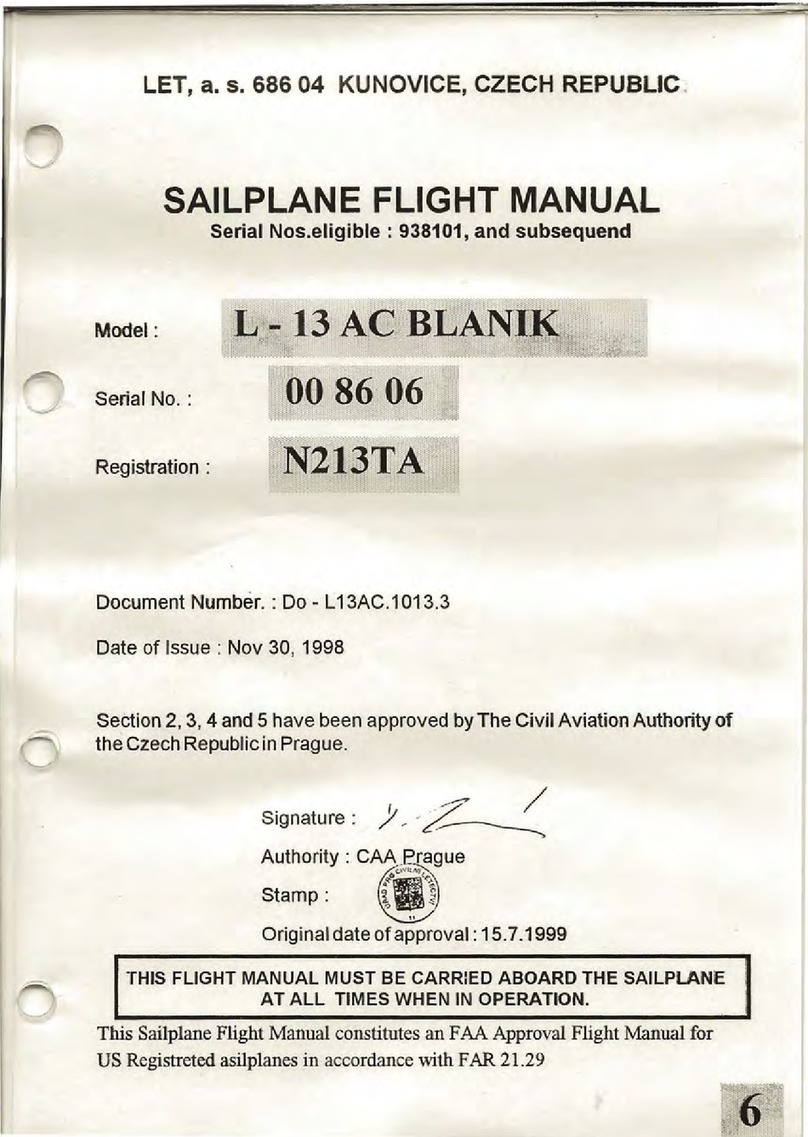
LET
LET L-13 AC BLANIK Flight manual
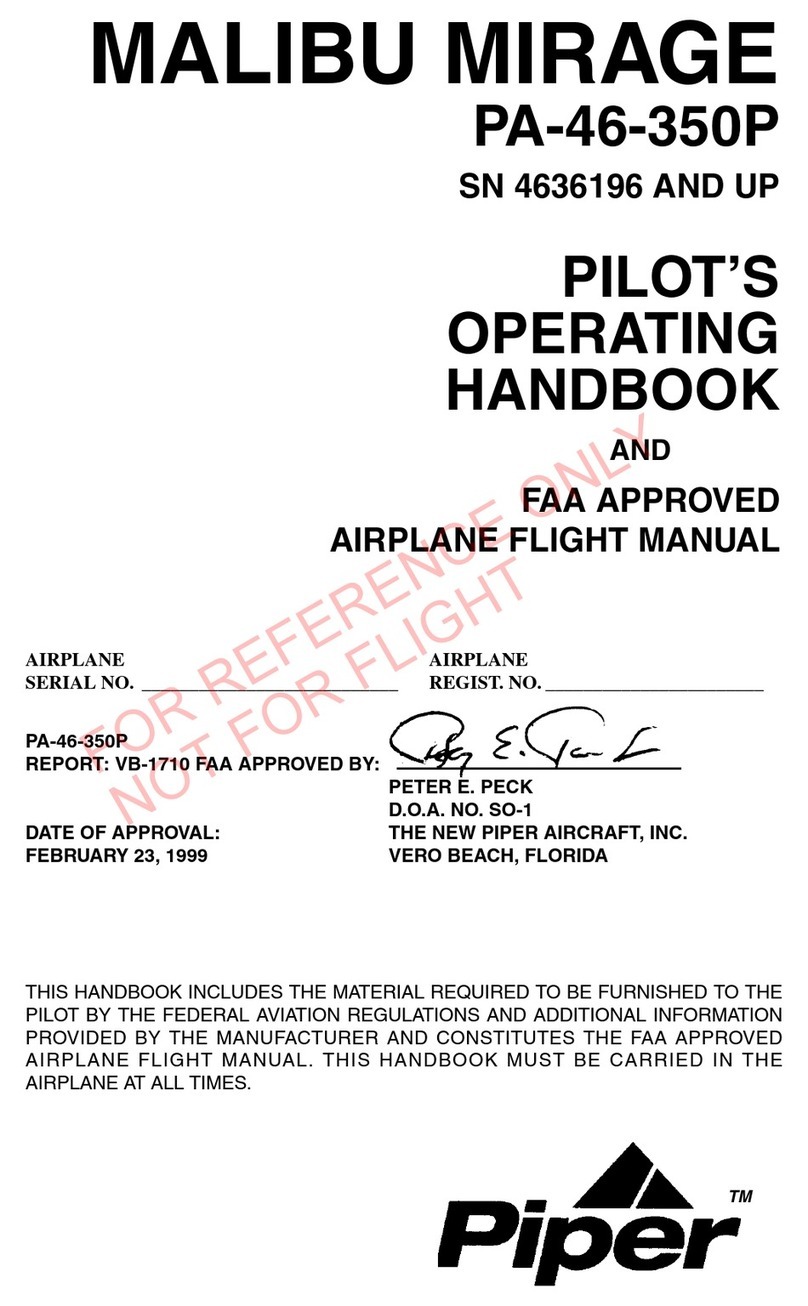
Piper
Piper PA-46-350P Malibu Mirage Pilot's guide and operation manual
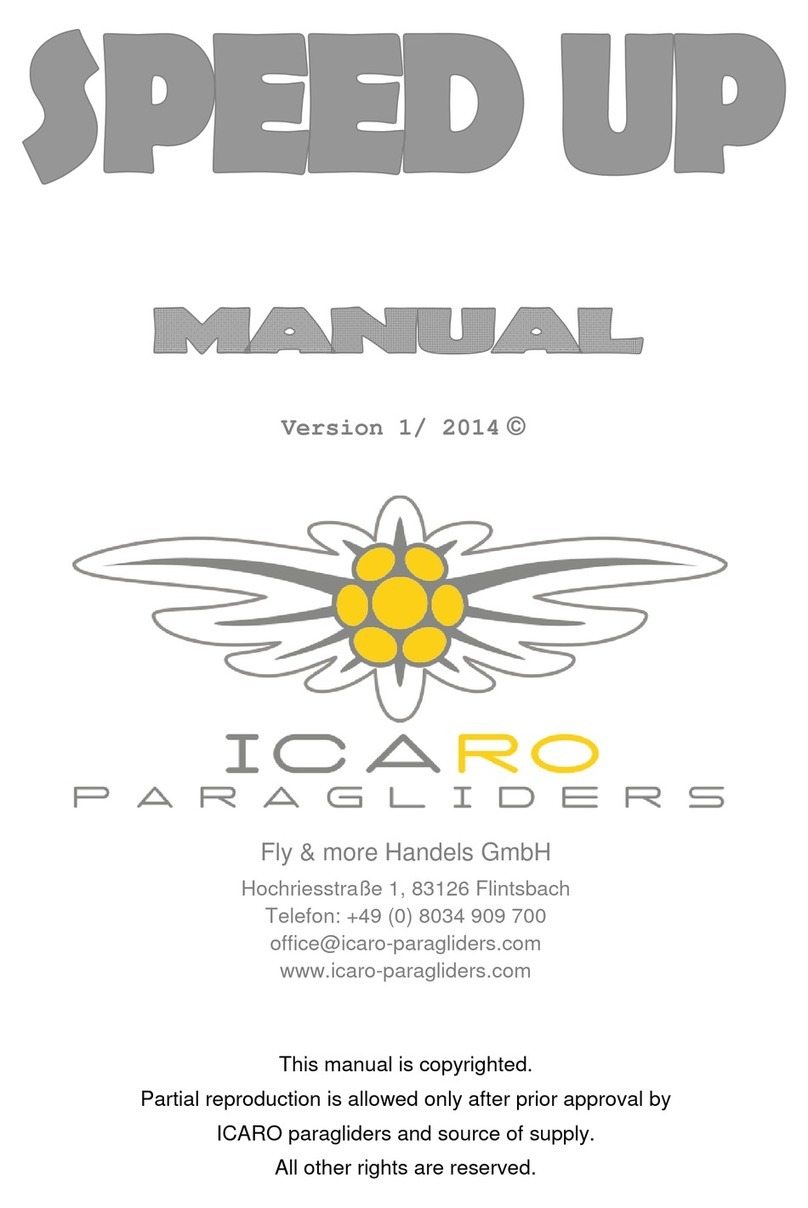
ICARO paragliders
ICARO paragliders SPEEDUP manual

Ozone
Ozone Roadster 3 Pilot's manual
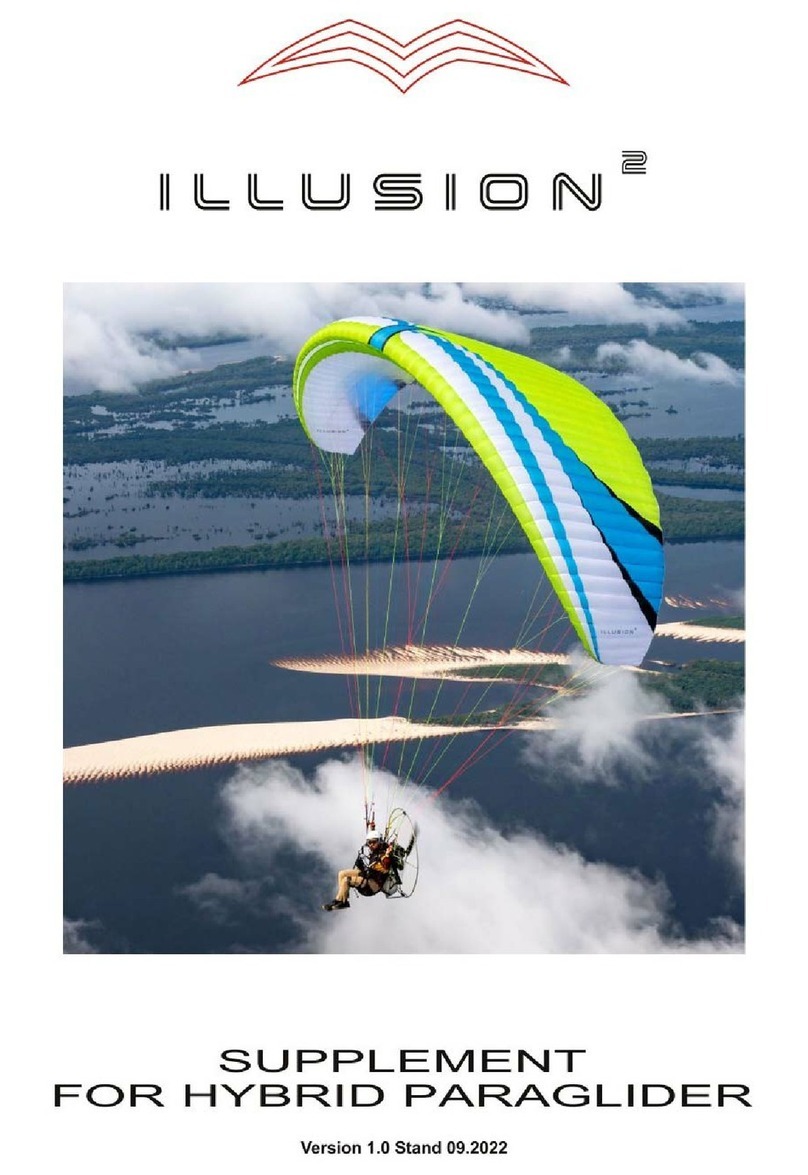
MAC PARA
MAC PARA Illusion 2 22 Supplement
